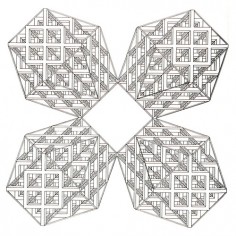Stanley Tigerman & G. T. Crabtree
The Formal Generators of Structure
source: prostheticknowledgetumblr
Architect Stanley Tigerman’s‘The Formal Generators of Structure’ (Architecture & Urbanism Journal, 1975) explored the combinatorial use of rectilinear shapes to generate volumetric, optical and architectonic compositions. Spatial configurations of the square and cruciform are extruded to create axonometric projections reminiscent of the ‘ideal’ geometricism of the De Stijl school. They are also reminiscent of the works of Op-artists such as Albers and Vasarely who toyed with the square to infinity through structural multiplicity and chromatic modulation.
.
.
.
.
.
.
.
source: dataisnature
Architect Stanley Tigerman’s ‘The Formal Generators of Structure’ (Architecture & Urbanism Journal, 1975) explored the combinatorial use of rectilinear shapes to generate volumetric, optical and architectonic compositions. Spatial configurations of the square and cruciform are extruded to create axonometric projections reminiscent of the ‘ideal’ geometricism of the De Stijl school and the works of Op-artists such as Albers and Vasarely who toyed with the square to infinity through structural multiplicity and chromatic modulation. Tigermans paper published alongside his series of drawings (with G. T. Crabtree) explores many other examples of squared axonometry in art and architecture noting that:
‘Two rationalizations of the Western World have focused on the unchanging qualities of the right angle. One has been synthesized in art as a formal universality in the form of the square. The other has been synthesized in religion as a spiritual universality in the form of the cross’
While pinpointing fundamental expressions of the square, historically, such as the Golden Rectangle and Le Modulor, Tigerman also looks forwards towards future computational strategies for composition.
‘As the world of art, as well as that of science comes to grips with ‘Systems Analysis’ and ‘The Field Theory’, it is necessary to formally analyze certain two dimensional, man-made diagrams to ascertain their fundamental characteristics to better under-stand the role they will play in the forthcoming computerized world of networks and lattices’
.
.
.
.
.
.
.
source: articedu
Stanley Tigerman was born in 1930 in Chicago, Illinois. From 1949 until 1959 he worked in several architectural offices such as the office of Keck & Keck, Milton Schwartz, Skidmore, Owings & Merrill and for builder A.J. Del Bianco. Tigerman was admitted to Yale University and received his bachelor’s and master’s degrees in 1960 and 1961. After graduating he worked in the office of Harry Weese before co-founding an office with Norman Koglin in 1962. In 1964 Tigerman opened Stanley Tigerman, Architect (now Tigerman McCurry, Architects). In addition to designing and building, Tigerman has taught for many years at the University of Illinois, Chicago, and in 1994 became co-founder and director of Archeworks, an alternative design school. Tigerman’s work has been widely published and has been the recipient of numerous design awards. He is the author of several books and has been the subject of many. In the 1970s he was one of the four original Chicago Seven, a group of young architects that helped change the prevailing Miesian vocabulary in Chicago. Tigerman was elected to the College of Fellows of the American Institute of Architects in 1973.


